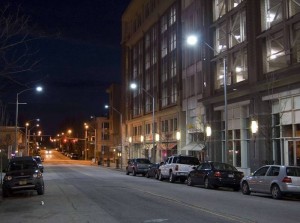In the largest street lighting retrofit ever undertaken by a city, Los Angeles is in the process of converting its 210,000 street lights to energy efficient LEDs.
Although the idea of switching the kind of lighting used may seem boring, street lights are responsible for 40% of cities’ energy bills, according to Pike Research, … and therefore, energy consumption.
There are about 35 million streetlights in the US, consuming 1% of all electricity.
"If every city followed the example of Los Angeles and reduced the electricity used by their streetlights by 50%, it would be equivalent to eliminating over 2.5 of those coal plants per year," says President Clinton. "We would do that while saving taxpayers money. And by doing that, we would also reclaim our night sky."
47 cities in Oregon are embarking on the same project, with Portland starting next month. Dozens of smaller cities in California have completed conversions and San Francisco plans to follow suit, along with Seattle, San Antonio and other cities. Baltimore saves $2 million a year after replacing 70,000 street lights.
By this June, Los Angeles will have replaced 140,000 energy hog lights with LEDs, and so far they’ve found even greater energy savings than expected – 63% less energy than high-pressure sodium streetlights.
That already adds up to saving more than $5.3 million a year, "far exceeding my expectations," says the city engineer in charge, Ed Ebrahimian.
It’s been a daunting project, replacing lights that span 4500 miles. The other 70,000 lights will be replaced in the second phase of the project. Los Angeles’s street lighting system is the second biggest in the US.
In 2008, Los Angeles spent $16 million a year to run streetlights. After this project, $7.5 million will be shaved off that bill.
In fact, the savings can be much greater. LEDs can save 80% of lighting energy if they are coupled with smart controls, according to a Climate Group report.
Switching to LEDs also vastly reduces maintenance costs because the lights last for 20 years.
Although some people don’t like the very white light LEDs give off, the increased lighting levels have improved visibility in residential areas, which among other factors, have reduced crime. Since the project started, the number of cars stolen have dropped 13.6%, burglary and theft is down 7.82% and vandalism has dropped 10.9%.
Many city conversion projects received funding from the 2009 Recovery Act, and the Los Angeles project was chosen as one of the energy efficiency initiatives of the Clinton Climate Initiative.
LEDs are quickly getting to cost parity with other kinds of bulbs. Pike Research expects sales of LED street lights to rise from less than 3 million last year to more than 17 million in 2020.


 Loading...
Loading...
LED Trail has been working hard to promote LED streetlighting within the West Coast to help local governments and municipalities Save Energy and Save Money. We are glad that our message has finally been received and acted upon. http://www.ledtrail.com
How does switching to LEDs “reclaim the night sky”? If anything, they are brighter. I’m for switching to LEDs, though I wish they could lower the brightness, and lessen the light pollution caused by street lights. I also wish they could harness sun energy and use that for power. Kind of a no-brainer in LA.
I presume that the reason that LEDs help to “reclaim the night sky” is because LEDs typically project light downwards only, whereas many other outdoor lamps direct light sideways and upwards as well, which results in upwards light pollution. It is usually this upwards light pollution which prevents people from seeing the night sky.
Does anyone know the manufacturer of LEDs that participated in this project?
Thanks.
I believe the LED’s are all made by Cree in the US. The full assemblies were originally provided by two vendors but assembled in China. The units include power conversion, lamps, reflectors, etc., and are a direct plug-in rwplacement dor the old units. LA has no installation labor cost because they simply have the crew that would have to replace a sodium lamp just install a new LED unit.
LED lighting does not “reclaim the night sky.” If shielding is being improved, that can help – with *any kind* of light. But white LED lighting increases sky glow dramatically – see http://www.flagstaffdarkskies.org/for-wonks/lamp-spectrum-light-pollution/